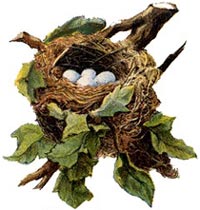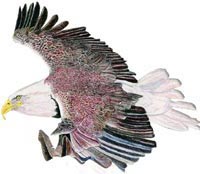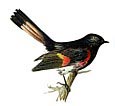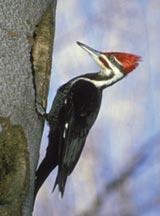| (insert your NIE or newspaper logo here) | Weekly Online LessonOnline Lesson ArchiveGrade Level: 7-12
|
Name That Bird
 For much of North America, spring weather offers a chance to open
up the windows and air out the house -- stuffy from winter's insulation.
For much of North America, spring weather offers a chance to open
up the windows and air out the house -- stuffy from winter's insulation.
Opening the windows not only brings in fresh air, but also fresh sound -- bird song from returning migrants and resident birds, who are busy bonding with mates and freshening up their homes for new families.
Birdwatchers (also called "birders") look forward to this time of year, so they can track familiar species and try to catch new ones to add to their "life list."
Some species are pretty recognizable nationwide: crows, bald eagles, pigeons, robins.
But for those of us who haven't done much birding before, trying to figure out the less common species can get confusing. Sometimes you might see the bird, and sometimes you might only hear its song.
Fortunately, the Cornell Lab of Ornithology website offers some basic birding tools to help you sort out different species you might see around your neighborhood or while traveling elsewhere. This week you'll also visit with naturalist host Sir David Attenborough, as he explains more in-depth about the life of birds.
All About Birds
 Let's start with the basics at All
About Birds to learn Birding 1, 2, 3, beginning with 1:
How to Identify Birds.
Let's start with the basics at All
About Birds to learn Birding 1, 2, 3, beginning with 1:
How to Identify Birds.
Read the introduction, then explore how to identify species using a bird's:
How is a crow's silhouette different from that of a dove? What are some of the ways you could differentiate between a plover and a nuthatch? Why would different bird species develop different flight patterns?
Okay, so now that you've got down some of the basics, try going outdoors with a regional field guide to help you identify some of the birds you're less familiar with. Take a notepad and jot down the different clues for identifying several birds you observe.
 After you've compared your observations with the field guide,
write down the names of the birds you've identified.
After you've compared your observations with the field guide,
write down the names of the birds you've identified.
Then, come back to the All About Birds site, and use the Online Bird Guide to see if you were successful in naming the species.
You can search by using the pull-down menu that's organized by Taxonomic Order or the one sorted Alphabetical by common name.
Each entry includes a fairly detailed description of the species, photos, an audio file of its song, range map, conservation status, and some cool facts. Go to the Detailed Page for even information about the species' preferred habitat, food sources, general behavior and reproduction.
Did the habitat in which you observed the bird match the guide books? What does the species eat, and where exactly would the bird you saw find that kind of food source? Is there an appropriate spot where the observed bird would nest?
 To watch some birds that may or may not live around your neighborhood,
check out the Video
Gallery and View species account for more information
on each bird. In what kind of habitat does each one live? Which species
might you find in your area, and during which seasons?
To watch some birds that may or may not live around your neighborhood,
check out the Video
Gallery and View species account for more information
on each bird. In what kind of habitat does each one live? Which species
might you find in your area, and during which seasons?
Of course you can go out and find birds, but you can also bring them to you! As you'll soon discover, there are several ways for Attracting Birds.
You can do it by Feeding Wild Birds, providing Nest Boxes, using Other Attractants, and by sprucing up the Landscaping to make it more bird-friendly.
Make sure to also review the Challenges you might face when attracting more birds to your yard.
Why do some bird species prefer different types of feeders? How can you guard a nest box from predators? In what way is your school or home yard already attractive to birds? What improvements could be made? What are some steps you can take to avoid window collisions?
The Life of Birds
 Now let's learn more about birds with host Sir David Attenborough
at the PBS site, The
Life of Birds.
Now let's learn more about birds with host Sir David Attenborough
at the PBS site, The
Life of Birds.
Here, learn about some amazing Bird Brains, some Evolution insight into different species, and discover some Champion Birds.
In what ways have different species adapted to habitats in order to tap into reliable food sources year-round? What adaptations allow some birds to live in extreme environments? What kinds of features allow other birds to live nearly everywhere humans live?
Next, find out how birds deal with Parenthood. How exactly does the shape of an egg make it crack-resistant? What are some tactics species use to protect and raise their young successfully?
Lastly at this site, discover how and why Bird Songs are important for species to communicate. What are some of the reasons that birds sing? What kinds of challenges do birds face when trying to get there message out?
Newspaper Activities
Browse current issues of The Salt Lake Tribune to find any photos or stories about birds or birdwatchers. If you see photos, can you identify the bird before reading the cutline? Was the photo taken in the bird's preferred habitat? If you come across articles about birds, has there been a particular species identified that's rare for your region? Are birdwatchers planning a special outing for their club or for the general public? If so, what habitat will be featured, and what kinds of species do they expect to see? If you find a science-based story about birds, have researchers discovered something new about a species?
© Copyright 2005
Learners Online, Inc.
